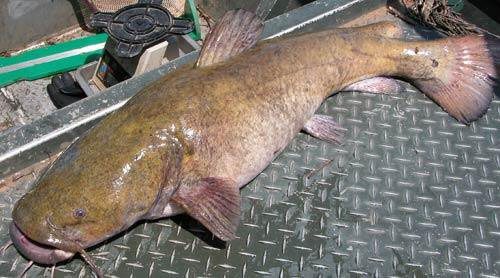U.S. Authorities Struggle with Invasive Fish Species
According to IFL Science, in the 1950s, fishermen in the western United States were introduced to a fish species originating from the Mississippi River and the Gulf of Mexico for food cultivation. After this fish was introduced into the country, it began to be cultivated in the river systems along the Atlantic coastline.
However, over 70 years later, in 2023, the Governor of Maryland had to urge the state government to declare this fish species a fishery disaster in the river systems of Chesapeake Bay. So, what is this fish? Why does it cause such headaches for U.S. authorities?
The fish we are discussing is the Flathead Catfish. Scientists are evaluating it as being on the path to becoming a top predator in U.S. waterways due to several factors.
First, let’s learn about the Flathead Catfish. (Scientific Name: Pylodictis olivaris) is a species of catfish belonging to the Order Siluriformes in the genus Pylodictis, categorized among freshwater fish in the United States.

The Flathead Catfish is considered a fishery disaster in the river systems of Chesapeake Bay. (Photo: Pinterest)
The Flathead Catfish is also referred to as a “river monster” as fishermen have caught individuals weighing up to 56 kg (approximately 123 lbs) and measuring over 1.55 m (about 5 feet).
Starting from summer, Flathead Catfish dig burrows for nesting. They usually create these burrows along riverbanks, in flooded areas, beneath fallen trees, in rocky crevices, and muddy pools. The breeding season lasts from mid-summer until mid-spring when water temperatures rise to 21 degrees Celsius (about 70 degrees Fahrenheit). They lay eggs in the burrows and protect them. Once they have laid their eggs, they remain in the burrow to guard them. When their habitat is disturbed, this giant fish will aggressively attack intruders.
Flathead Catfish prefer to live alone, making them harder to catch than other species of catfish. They typically hunt by ambush at night, hiding and waiting for prey to pass by before striking.
The reason Flathead Catfish are considered a harmful invasive species in U.S. waters is due to two main factors.
First, Flathead Catfish are voracious eaters. When this species was introduced into the river systems along the Atlantic coast, they readily consumed all types of animals that conservationists are trying to protect. Joel Fleming, a biologist at the Georgia Department of Natural Resources, stated: “Flathead Catfish will be one of the top predators in every system where they establish a population because they eat anything that fits in their mouth.”

Flathead Catfish eat anything that fits in their mouth. (Photo: Pixabay).
In 2016, an American fisherman witnessed a Flathead Catfish attempting to swallow its mate while the latter struggled to escape. According to scientists, Flathead Catfish have poor eyesight and often try to eat anything that moves. Consequently, they are even known to cannibalize their own species. When fishing for this species, anglers must use large bait, such as carp weighing up to 2 kg (about 4.4 lbs).
Second, the population of Flathead Catfish thrives due to their prolific breeding. Depending on their size, some females can lay up to 100,000 eggs per spawning. Males will protect these eggs until they hatch after more than a week. The fry begin to eat live fish once they reach a length of 10 cm (about 4 inches).
U.S. scientists believe that if Flathead Catfish are allowed to thrive unchecked, they could wipe out native wildlife in the river systems along the Atlantic coast in just 30 years. For this reason, they have warned authorities to encourage fishermen to report any Flathead Catfish they catch instead of releasing them back into the water to protect the native ecosystem.


















































